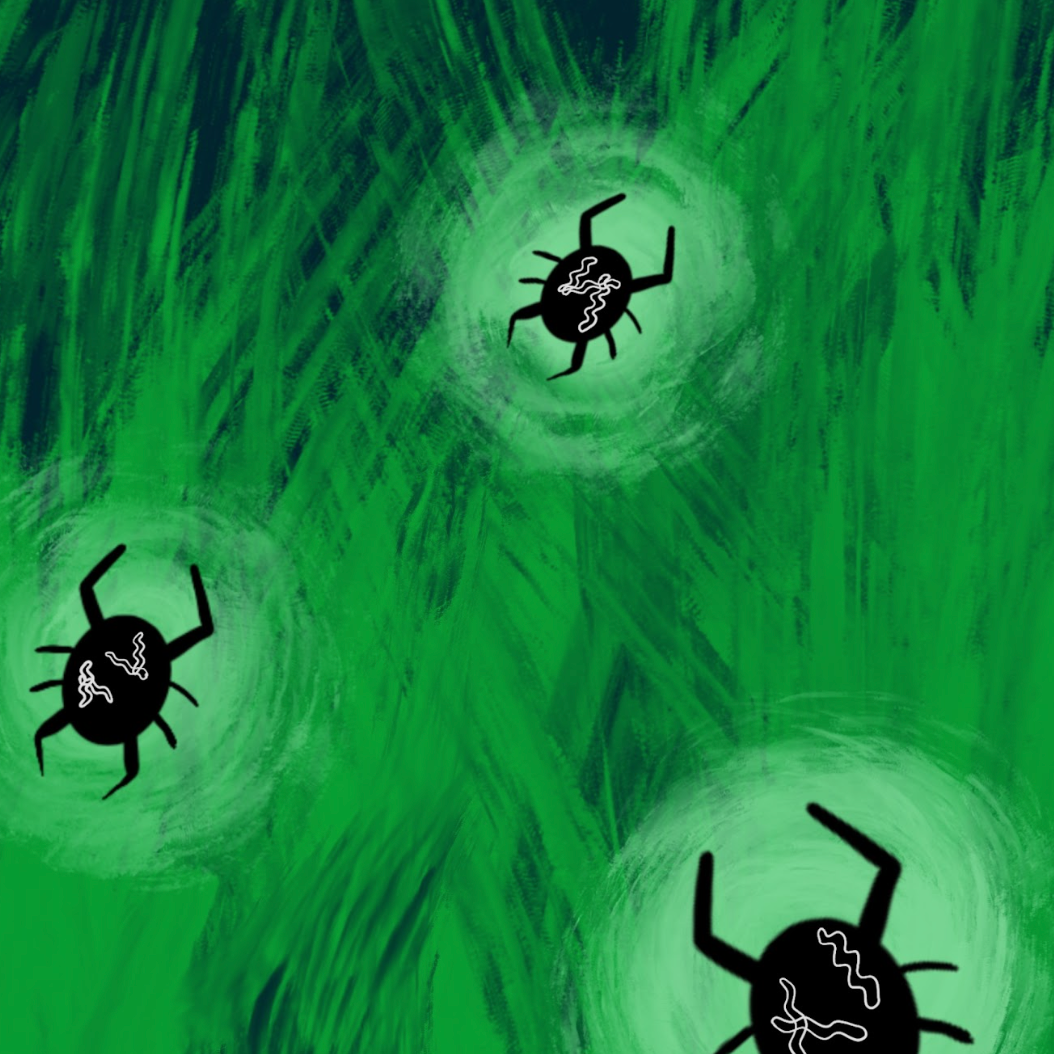The savage tick-borne illness that is Lyme disease has been plaguing America since the 1970s, and the Centers for Disease Control and Prevention estimates that as many as half a million Americans will suffer from early-to-late-stage chronic Lyme disease every year.
Deer commonly host the bacterium, Borrelia burgdorferi, that ticks pick up when instinctually biting a deer. When a human then gets a bite from a tick, Borrelia infests the human body and — if not detected in a timely fashion — can cause irreversible damage. The longer the bacterium is left in a person’s blood, the chance of the infection turning chronic and incurable is intensified.
A bullseye rash will appear after getting a tick bite 70-80% of the time, indicating a trip to the doctor for a round of antibiotics. When treating the infection early, rarely are there lasting symptoms. If a rash does not appear, the symptoms presented can be mistaken for the flu.
Lyme disease attacks most aspects of the human body including the brain, joints, heart, and all-over body weakness or numbness. A single bite from a tick can lead to multiple sclerosis, Lyme carditis, paralyzation, chronic fatigue, Bell’s palsy, and many more severe manifestations.
Statistics show the quality of life for some patients with chronic Lyme disease have a worse quality of life than congestive heart failure patients. The ultimate wonder is why this disease lacks attention.
As a society, people focus on illnesses that cause crises and fatalities, like cancer or Alzheimer’s. Cancer is commonly treated with chemotherapy, a drug treatment that makes big pharmaceuticals money. Unlike chemotherapy, Lyme disease treatment lacks the desperation that will preserve a person’s life.
People are more willing to participate in expensive treatments when said treatments will — hopefully — save their lives. Because chronic Lyme disease has a low fatality rate, doctors cannot prescribe an expensive, vital medication. There is doubt that researchers would spend their time on something that will not make big pharma a lot of money.
Not only is time a factor, but the research is long-under-funded.
Considering the disease can lead to death (although rare), an abundance of research, testing and treatments available to efficiently halt the disease from becoming progressively debilitating are pertinent.
While I have been fortunate enough to not have contracted this disease, I am one of the millions of people who have witnessed a loved one combat debilitating symptoms and fight for the proper care.
My partner and lifelong best friend was diagnosed with late-stage chronic Lyme Disease, received minimal care, and has been struggling with the disease ever since. The care for Lyme is minimal and there is no cure or vaccine.
Not only is care scarce, but the diagnosis itself was unnecessarily drawn out. After experiencing swollen lymph nodes and fatigue, doctors started testing for lymphoma, creating an exceptionally traumatic experience.
My partner had been a carpenter in Buffalo for many years doing residential and outdoor work, and at the time of diagnosis was building a luxury log home in the Adirondack Mountains — somewhere Lyme Disease is most frequently reported. i.e., in the northeastern and upper midwestern states.
It wasn’t until months after biopsies, blood work and testing for multiple different illnesses that they asked the very important and essential question: “What do you do for work?”
Directly following the answer to that question, doctors began testing for Lyme.
Because Lyme is so common in the United States, testing for the disease once a year to catch it early on and prevent a chronic manifestation should be required.
The doctor who gave the initial Lyme diagnosis reached out at the start of the COVID pandemic and expressed that we be especially safe, due to Lyme weakening the immune system.
During the many visits, due to a variety of troubling symptoms, ER doctors and general physicians have done nothing but disregard and downplay the diagnosis. The ignorance of doctors is especially concerning considering half a million Americans are diagnosed with the disease each year.
Often, countless doctors dismiss and belittle Lyme disease, making the impending doom of a Lyme diagnosis grim and debilitating. Many general practitioners misdiagnose due to minimal exploration and ignorance of symptoms.
Though doctors acknowledge Lyme disease (sometimes), chronic Lyme disease is a large debate in the medical world. Controversy about chronic Lyme disease is so popular that the term “Lyme Wars” has been coined to name the debate.
Debating about a bacterium that is proven to be causing people a great deal of pain and confusion is an unexplainable disservice to the struggling population of Lyme disease patients. Because the main treatment for the disease is a course of antibiotics to stop the replication of bacteria in the blood, it is really of no help to the chronic stage patients. Doctors should be striving to find not only better treatments but more natural and helpful treatments.
While Lyme literate doctors (LLMD)— physicians who specialize in Lyme disease and care — do exist, their care is seldom covered by health insurance, leading to a daunting and expensive journey to feeling better.
With a long list of disabling symptoms, the rate of unemployment in the community is excessive. On account of the lack of awareness scholars and the general population have, most employers and doctors would never consider Lyme disease to be a disability. A lack of sympathy makes survival extremely strenuous, but medical professionals are arguing if chronic Lyme disease even exists.
Witnessing the despair this illness has caused, I became obsessed with reading about Lyme disease and treatments that could work. I was willing to do anything to bring my partner relief, but it wasn’t my body.
Checking off the plethora of treatments that might work and either feeling worse or getting no relief is exhausting in itself. Because doctors seldom offer treatments that help, finding treatments that work is up to the patient.
While doing my own reading about the disease and exploring many treatments, Ozone and UV Blue Light Therapy seem to have a positive effect (for my partner) on debilitating symptoms that include: severe joint pain, lethargy, headache, numbness in the limbs, dizzy/fainting spells, general malaise and spells of not being able to move at all.
Not only are the symptoms physical, but they have aided in multiple years of struggling with intense depression—which also lacks care.
Throughout this journey, I have found it incredibly soul-crushing to see a loved one go through such anguish and struggle.
Learning and teaching about Lyme disease will spread awareness and expectantly raise money for better research. As a population that holds power over what they consume, the masses choose to ignore diseases that are not in the public eye. If we can spread awareness and sympathy about under-funded disease research, there is hope that even the most complex illnesses can be cured or treated.
If you or a loved one experiences a bullseye rash or suspects a tick bite, contact a doctor for testing and treatment as soon as possible, because it could truly save a life.
Carlina Krajnik is an opinion writer. Contact her at [email protected].





Karinne • Oct 4, 2023 at 9:02 am
Very good , well written. Keep doing it Nina I love you
Stephanie Starkey • Oct 3, 2023 at 7:46 pm
Wow, this was such an eye opening article that led me to more “googling” about the subject. I didn’t realize how prevalent this disease is nonetheless how unbelievably underfunded and neglected it is still to this day in the medical community. Very well written and informative, definitely looking forward to more articles like this.
Kim math • Oct 3, 2023 at 12:24 pm
Great job Carlina that was very informative. So proud of you girl. Love and miss you both.